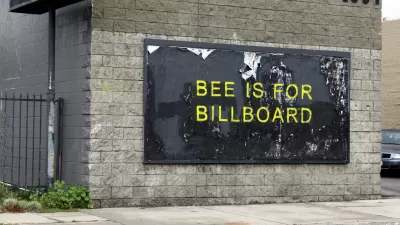A city-hired consultant has recommended an expansion of the areas where digital billboards are allowed in Toronto. The sign industry claims the billboards contribute to “vibrancy” but critics argue they're an unwelcome intrusion into public space.
A recently released report from a city-hired consultant recommends permitting digital billboards in commercial and employment zones in Toronto, where they are currently forbidden. Meanwhile, Betsy Powell notes, “some U.S. cities, such as San Francisco, Denver, Houston and St. Louis, have banned them outright.”
“Opponents call [digital billboards] ‘visual pollution,’” writes Powell. “They say they pose a dangerous distraction to motorists and emit vast amounts of light that could potentially disrupt the sleep of thousands of downtown condo dwellers."
“On the other side,” she continues, “is the outdoor sign industry. It says there is no statistically significant link between electronic signs and car crashes and that the brightness of the signs can be adjusted within specific limits. Digital signs contribute to the vibrancy of the city, they say.”
"What nobody disputes is that digital billboards are an extremely lucrative business, especially in Canada’s most populous city."
FULL STORY: Toronto's advertising sign companies push hard for digital billboards

Americans May Be Stuck — But Why?
Americans are moving a lot less than they once did, and that is a problem. While Yoni Applebaum, in his highly-publicized article Stuck, gets the reasons badly wrong, it's still important to ask: why are we moving so much less than before?

Using Old Oil and Gas Wells for Green Energy Storage
Penn State researchers have found that repurposing abandoned oil and gas wells for geothermal-assisted compressed-air energy storage can boost efficiency, reduce environmental risks, and support clean energy and job transitions.

Placekeeping: Setting a New Precedent for City Planners
How a preservation-based approach to redevelopment and urban design can prevent displacement and honor legacy communities.

Study: Maui’s Plan to Convert Vacation Rentals to Long-Term Housing Could Cause Nearly $1 Billion Economic Loss
The plan would reduce visitor accommodation by 25,% resulting in 1,900 jobs lost.

Idaho Data: Unexpected Vehicle Repairs Exacerbate Housing Instability, Eviction Risk
Over 21 percent of clients struggle with transportation barriers.

A Year-Long Investigation On Permanent Supportive Housing
The New York Times reveals what’s working and what’s not in the cornerstone of Housing First.
Urban Design for Planners 1: Software Tools
This six-course series explores essential urban design concepts using open source software and equips planners with the tools they need to participate fully in the urban design process.
Planning for Universal Design
Learn the tools for implementing Universal Design in planning regulations.
Heyer Gruel & Associates PA
City of Moreno Valley
Institute for Housing and Urban Development Studies (IHS)
City of Grandview
Harvard GSD Executive Education
Salt Lake City
NYU Wagner Graduate School of Public Service
City of Cambridge, Maryland




























